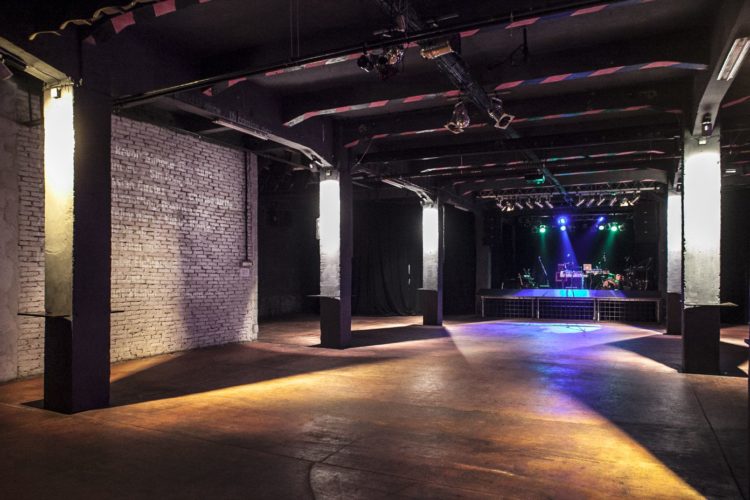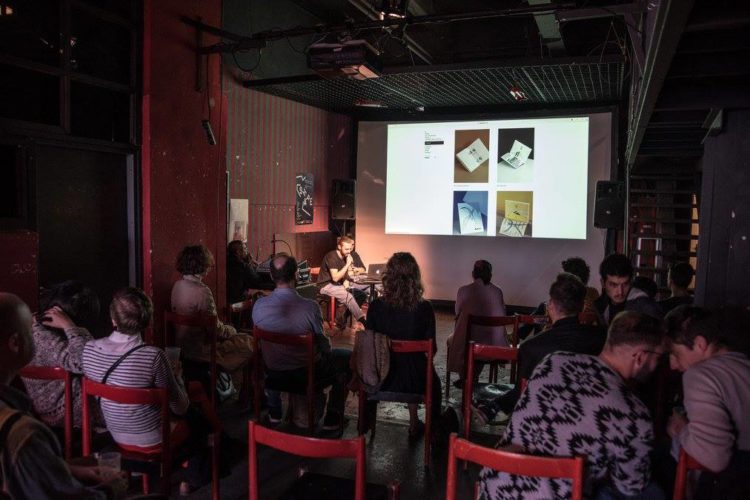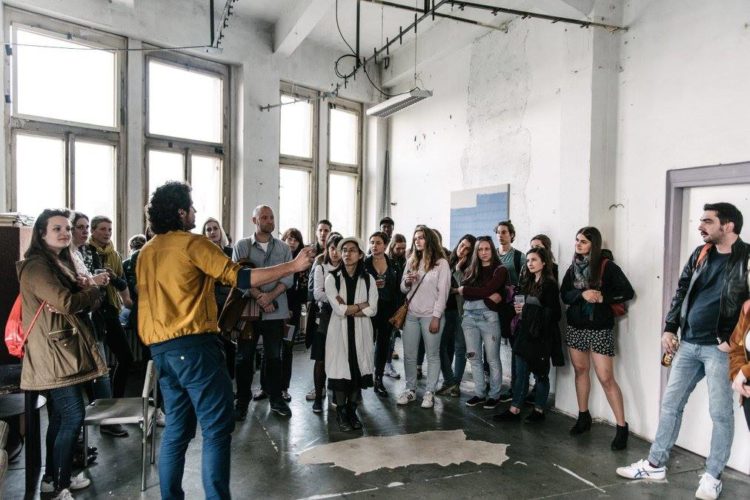Lately I’ve been feeling dispirited by the Bucharest art scene. Times are hard, money is scarce and morale is low. The capital’s independent sector is struggling to keep things in motion, to put forward a diverse agenda of events with what little resources are available and hope for a future where even the average Joe can easily embrace contemporary art. But this might happen later rather than sooner within Bucharest’s tiny yet strikingly fragmented community: while independent artists and cultural managers would sooner jealously criticize each other rather than extend a helping hand, the capital’s big art institutions are busy making bad administrative and financial decisions that couldn’t possibly benefit the artistic community in any way. This might sound harsh, but once you see the selfish mechanism that drives various art institutions, the “every man for himself” attitude and the lack of community spirit, it’s pretty hard to unsee it. The reason is obvious: ferocious capitalism inertia that seems to be the main drive behind any initiative, artistic or otherwise, the main symptom of post-communist freedom that is still very much lurking around with no sign of going away any time soon.
In the art world this translates into all sorts of artist cliques always gossiping about each other, artist-run spaces closing left and right due to lack of funding and little to no platforms for promoting young artists at the beginning of their careers. It’s as if Romanian soil is no longer fertile: if one manages to grow something here, they would very much rather keep that for themselves and enjoy the fruit of their labor alone than share it with anyone else. On the other hand there are those who sit on the sidelines and perceive their peers’ success as their own failure. Although I don’t condone this kind of mentality, I can understand where it’s coming from. With greed, competition and plain old disinterest in the air, this hostile environment can definitely discourage someone from even attempting anything, let alone looking out for others.
During my residency in the beautiful city of Prague, I wondered the streets looking for a sense of community but, as it turned out, I needed not look further than my own backyard. During my short stay, I was a guest at the famous MeetFactory, internationally known for being the largest artist-in-residency studio program in Central Europe and locally known as a hip venue for concerts, parties, theater plays and more. Their main goal is to place the institution in the collective consciousness of the city and to be perceived as more than just a gallery space. So far, it’s living up to its literal name: The MeetFactory is known as a great theater for fans of the genre, an awesome club and concert venue for music lovers and an all-round proper and trustworthy art institution for the local art scene and beyond. They strive to build a platform for communication and networking between the local scene and international players. This shouldn’t come as a surprise, seeing as Prague is much more close to other art centers like Berlin or Vienna; artistic exchange and learning are more easily facilitated, setting the standards pretty high.
Located in the Smíchov quarter of Prague, in a unique space squeezed between a motorway and an active railroad, MeetFactory is currently hosted by a former glass factory that has been expertly converted into the kind of place where there’s always something going on. Their non-profit agenda centers around making art in all its forms accessible to more than just the regular art crowd. With two gallery spaces and an art wall, a concert hall for music and theater, a bar that stays open all the time (not just during the events) and numerous art studios and residency flats, the institution is split into four departments that work towards attracting a wide audience. The music, theater, gallery and artist-in-residency departments each have their own director, staff and subsequent agenda expertly planned out and overseen by the board composed of artist David Černý, musician David Koller and film and theater director Alice Nellis. But it wasn’t smooth sailing from the very start. At the beginning, in 2001, the space was set in an old meat factory, hence the play-on words, but just one year later, major floods forced the organizers to evacuate and look for a new space. It took them a while, but finally, in 2007, the MeetFactory opened its new venue and artistic program which has been running smoothly ever since.
I couldn’t help but compare this institution with similar ones back home, or at least I wanted to, but there really is nothing to compare it to. In my quest for Romanian institutions that function as an all-in-one organism in order to constantly draw in visitors, I thought of the Paintbrush Factory in Cluj, formerly known as the most spectacular art center in Romania, hosting up to 29 spaces for galleries, artist studios and dance and theater halls. But corruption inevitably found its way into the heart of the Factory, which lead to a major rift between the organizers, splitting the once renowned center into two separate entities that are always at each other’s throats. The ones left to pick up the pieces where the artists and now the complex itself is only a shadow of what it used to be, resorting to renting out half of its quarters for office space. Talk about community spirit…
Back home in Bucharest, the only art hubs that marginally resemble the MeetFactory that I could think of were the National Contemporary Art Museum and Combinatul Fondului Plastic. And marginal doesn’t even begin to describe it. After closing down its annexes one by one, the MNAC itself can audaciously afford to take some time off and close its doors to the public for two whole months, invoking the excuse that the museum needs time to prep for its seasonal opening. But that’s OK; outside of major events and openings, the museum hardly has any visitors. This might also be due to the fact that, even though it is situated smack in the middle of Bucharest, it’s incredibly hard to get there. Even with the newly inaugurated public transport line meant to connect the city’s museums, MNAC is still not as accessible as the MeetFactory which, although pretty far from the city center, it is still easily reachable via the city’s incredible transport system. Sure, there are cultural managers at the museum who still struggle to attract more than just art lovers with the new contemporary theater department, sound-art events and parties on the terrace, summer schools and kid friendly activities. But that’s not nearly enough to make up for MNAC’s disastrous management issues and lack of transparency: the museum has become quite renowned for not honoring its contracts via legislative loop-holes and leaving artists and curators blindsided. Digging deeper still, we find employees too busy or unwilling to assist or give any straight answers, but I get their lack of commitment with all their overdue salary payments. A lot has been said about director Călin Dan’s handle on the museum and his creative differences with the museum’s curators who’ve left one by one. It’s such a pity; MNAC definitely has the resources and man power to pump some life into the anemic artistic community, but it would rather invest in bland shows and cheap tricks to keep the money flowing.
As for Combinatul Fondului Plastic, which is also of hard to get to, there is plenty of room for improvement. The CFP, working under the Romanian Artist Union, is only starting to convert its old industrial warehouses into art spaces and it has yet to coagulate into a unitary entity. But perhaps, under the right management, it could become a hip new art hub that could attract a wide audience even outside of openings: the place is big enough to house a concert hall, a theater and even a terrace bar that would make the long ride there worthwhile. Right now, it’s just a bunch of separate galleries that don’t even bother to keep their doors open when there’s an opening in the area. However, the CFP has the potential of establishing new local and regional connections: it holds quite a few of unused rooms just waiting to be converted into artist studios or residency flats, all it takes is setting some priorities straight.
Fortunately, not all hope is lost for the Romanian capital. There are a lot of small initiatives working towards solidarity and bringing more to the public. ODD’s cramped headquarters in the heart of old town Bucharest doesn’t function as just a gallery space, it also hosts an array of sound events, concerts and informal discussions, talks and workshops, as well as a collaboration with ARC Bucharest for a series of curatorial residencies. ODD could benefit from a round-the-clock open bar in order to attract visitors outside of major events and turn the place into a veritable artist hotspot. MACAZ, on the other hand, is an autonomous cooperative that mostly functions as a bar and a clubbing venue with affordable prices and a very diverse pallet of events. Born from the ashes of the Claca, previously working in another abandoned-factory-turned-art-hub that shut down two years ago in the wake of the Colectiv tragedy, MACAZ often converts its dance floor into a black box for political theater or a round table for politically driven discussions, and is also home of The Political Art Gazette.
Places like these prove that people dream of better support systems for artists in the city. I remember the days when the MNAC Annex was alive and kicking, when you would go see an exhibition at Salonul de Proiecte and you could also visit Platforma, which kept its space open after hours. The MeetFactory atmosphere reminded me of Platforma, which was once the place to be if you were an up-and-coming artist and you needed a space to work and showcase your projects. Sure, there wasn’t always a production budget and you would often have to bring your own materials from home, but the space and the people working there (most of the time unpaid) would offer the moral support that kept you going. But all good things come to an end, it seems that the MNAC had no desire to keep this initiative going and the Annex got shut down like so many others. Nowadays, the bigger players of cultural management seem to be focusing on ephemeral and often questionable events and standalone exhibitions, capitalizing on the short-term gains, instead of long-running commitments, investing in cultural education or leaving behind some kind of legacy. Like I said, infertile soil…
We could learn a thing or two from the MeetFactory’s impeccable structure. From dawn till dusk, the factory is bustling with people: gallery visitors, artists working in-studio, play rehearsals, party set-ups, discussions or just plain hanging out at the bar and terrace. There’s always something going on! Internally, there are bound to be conflicts of interest where the director and the curators can’t see eye to eye, but a solid functional structure that places the right people in the right positions with very clear job descriptions leads to more fruitful collaborations and less misunderstandings and miscommunication.
I was particularly interested in the artist-in-residency program, especially since I found myself participating in various activities with the other residents. During a field-trip in neighboring art-city Ostrava, I sat down with curators Lucia Kvočáková and Piotr Sikora and production manager Nora Nesvadbová to tell me more about the largest studio program in Central Europe.
The non-profit institution has 10 artist studios and numerous flats within the industrial complex as well as around Prague and hosts over 30 artists, curators, musicians, theater directors and writers each year. The whole idea is not just to offer artists a space to work in, an exhibition and some cash, but to include the artists in the rich Prague art scene and establish new connections. The residency program is based on MeetFactory’s collaboration with various international art institutions across the world: AIR Antwerpen, ARTPORT Tel Aviv and the U.S. Embassy to name a few. Since 2016 the residency program is based on invitation only, the curators and the gallery department oversee everything and there seems to be no clear formula for who gets a residency here. Some international institutions organize open calls for their local artists and put together a shortlist from which the factory gets a pick. The program doesn’t just cater to international artists, curators can also invite Czech artists to occupy their studio spaces. It also works both ways, as an exchange program with their partners, so local artists and curators also benefit from this amazing program.
However, their selection system seems to be a closed circuit. The gang told me that before 2016 there used to be a yearly international open call but it turned out to be too much of a hassle. Each year they would have to go through thousands of mediocre to bad applications in order to find a couple of artists worth their while. So basically, you either hope there’s a partnership with some institution from your native country or you can try to get on the curators’ good side. From this perspective, one might be inclined to say that networking, or nepotism even, weigh in more than actual quality contemporary art production; however, once you feel the sense of kinship within Prague, all suspicion vanishes. It was heartwarming to witness art people bonding over something positive for a change, whereas back home, I am used to people coming together only in dire situations. What I appreciated the most about Prague in general and The MeetFactory in particular, is the care with which everything is handled and the desire to actually help your artist brother out.
For those of us who’ve been in residencies, everything is great and all, but it often gets quite lonely. However, if you’re set to stay at The MeetFactory, you won’t be cooped up in your little studio and forgotten until you emerge back out with the finished product. The residents aren’t alienated in their quarters, cut off from the cultural life of the city, on the contrary, over the 2-3-month period of their stay, they are included in an array of “extra-curriculum” activities that not only acquaint them with the local art scene, but also open up new opportunities for future collaborations. Even though I wasn’t a full-time resident at the MeetFactory, due to my short stay, my hosts were gracious enough to include me in one of their field-trips. Indeed, although coming from diverse artistic backgrounds, the residents were all collaborating under the cultural managers’ supervision to set up a small pop-up exhibition that would showcase their works outside the Prague artistic sphere. Art collectors and local Czech artist frequently visit the MeetFactory studios but the spaces are also open to any visitor who wants to get a sneak peak of a work-in-progress or wants to keep the residents company. The weekly coffee hours and office meetings assure a time and place where residents and organizers catch up and keep in touch and a trusty group of interns are always available to promptly answer any email at any given hour. Here, the artist is king!
So, what does the MeetFactory have that Romanian institutions do not? A stable budget and a good handle on it, for one: each department has its own separate budget plan and earnings. As for the residency program, with a 4-year grant from the City of Prague, a yearly budget from the Ministry of Culture, support from the international partners and some cash coming in from renting out the industrial spaces when they’re not in use, the MeetFactory is definitely not going anywhere. In fact, Piotr and Lucia laid out their future plans, an ambitious new program centered around networking and research, not just for the local scene, but the regional sphere as well, bringing together Eastern and Central European artists, curators, critics, researchers. Hopefully, this initiative, which also includes Romania, will set an example for our local institutions and make the artistic community reconsider its priorities. If not, then at least we can be grateful for international programs like this one that keeps us in mind.
Marina’s residency in Prague was made possible with the support of AFCN.
POSTED BY
Marina Oprea
Marina Oprea (b.1989) lives and works in Bucharest and is the current editor of the online edition of Revista ARTA. She graduated The National University of Fine Arts in Bucharest, with a background i...
marinaoprea.com














Comments are closed here.